Visit Kenya's stunning wildlife in one of the numerous National Parks and -Reserves:
Maasai Mara National Reserve
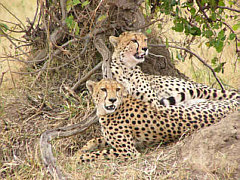
Maasai Mara National Reserve, also spelled Masai Mara or Massai Mara, for most locals short 'the Mara', is situated within the Great Rift Valley in south-western Kenya near the
border to Tanzania. Southern Kenya is Maasai land, and here Maasai communities maintain a traditional way of life. Maasai Mara is the northern-most section of the Serengeti-Mara
ecosystem and as such an important area within the circle of the Great Migration, the yearly wandering cycle of millions of wildebeest and hundred thousands of zebra. Maasai Mara's
topography is characterised by wide, open savannah plains with clusters of acacia trees, woodlands and riverine forest.
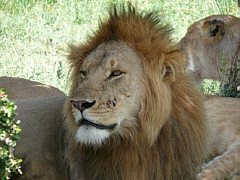
This world famous reserve is home to the richest concentration of wildlife, not only including the "Big Five" (elephant, buffalo, lion, leopard and rhino) but also an array of
other animal species with large grazing herds of zebra, Grant's and Thomson's gazelle, impala, wildebeast, hartebeast, eland and topi atelope. So much food available attracts large
numbers of predators like lion, leopard and cheetah as well as hyaena and jackal. Maasai Mara is well known for it's huge concentration of lions and a very good chance to spot
cheetahs or even watch them hunting. With a bit of luck leopards can be seen in the riverine forest along the Talek River.
Beside many kinds of birds of prey and vultures, ostriches, secretary birds, marabous, and various bustards and fowls, the acacia woodlands are alive with birdlife of all sizes,
belonging to over 400 different bird species. The Mara and Talek rivers, important water sources for the reserve, are home to hippos and crocodiles. The population of black rhinos is
severly threatened all over africa; Maasai Mara is home to a remaining number of 20 - 24 individuals.
The central area of the Maasai Mara, 1510 square kilometers or 583 square miles, protected as a National Reserve, is surrounded by a semi-circle of group ranches such as Koiyaki,
Lemek, Ol Chorro Oirowua, Olkinyei, Siana, Maji Moto, Naikara, Ol Derkesi, Kerinkani, Oloirien and Kimintet. In these areas of the Greater Mara Ecosystem wildlife shares it's habitat
with grazing Maasai cattle.
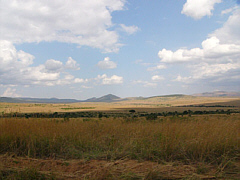
The altitude of Maasai Mara's vast area is between 4,875 and 7,052 feet above sea level, resulting in a more moderate climate with daytime temperatures around 85 degree F (30
degree C) wich drop to around 60 degree F (15 degree C) at night. Maasai Mara uses to experience a regular rainfall season twice a year, usually between March and May and in
November/December, but not neccessarily happening exactly at these times. June and July are considered as the coolest months while the hot temperatures peak in December and January.
Dry weather, lush vegetation and pleasant daytime temperatures make the period of July to October the best time to see the park's wildlife, but also resulting in the highest numbers
of visitors during this period. December to March are also considered as a very good visiting period with pleasant weather while April to June are still also good months but might be
rainy or cool.
Maasai Mara National Reserve is one of the best places in Africa to view wildlife, especially the big cats and to experience what is concidered as one of the greatest spectacles
in the natural world, the Great Migration of millions of herbivores crossing the Mara River and grazing in the Mara plains for four months between July and October.
Samburu National Reserve / Buffalo Springs / Shaba
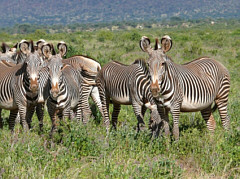
Samburu National Reserve is situated within the Rift Valley Province in central Kenya, on the banks of the Ewaso Nyiro River. It is a dry, hot and arid area characterised by a
rugged, parched landscape of hills and savannah plains. The sun baked landscape is breathtaking with surrounding mountains shimmering on the horizon as temperatures rise. To the west,
the sheer sided slopes of majestic Ol Olokwe Mountain form a perfect back drop to any photograph. With approximately 104 square kilometers (approx. 65 square miles) in size, this reserve is relatively small in comparison to
other parks such as Maasai Mara or Tsavo. But the presence of the river and its shady trees attracts plenty of wildlife like giraffe, buffalo, elephant, gerenuk, Kirk's dik-dik,
impala, waterbuck and common zebra as well as the endangered Grevy's zebra. Lion, leopard and cheetah are also quite easy to spot, thanks in part to the lack of grass cover.
Around 365 species of birds including eagles, bateleurs, vultures, ostriches, kingfishers, sunbirds, hornbills, starlings, marabous, guinea fowl and many many others have been
recorded and the Ewaso Nyiro River area, home to hippos and a huge population of crocodiles, is particularly rewarding. Wildlife unique to the northern parks and reserves of Kenya
and to be found in Samburu are the Grevy's zebra, reticulated giraffe, Beisa onyx, somali ostrich and the long necked gerenuk.
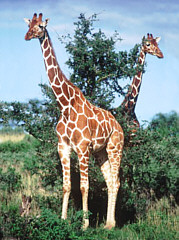
The Reserve's name is derived from neighbouring the homes of the Samburu tribe, known for their remote culture and nomadic, pastoral way of life. Samburu was one of the two areas
where George and Joy Adamson did their research on lions and raised 'Elsa the Lioness', made famous by Joy's bestselling book and later also award-winning movie 'Born Free'.
Samburu's climate is hot and dry at daytime and cool during nights (average maximum around 85 degree F (30 degree C) and average minimum around 70 degree F (20 degree C). There
is not much rainfall, the total is only 350 mm per year, occuring mostly from March to May and additional short rains in November and December. The periods from January to March and
from July to October are usually hot and dry and considered as the best months to visit Samburu National Reserve. April to June are also good for a visit but might be rainy.
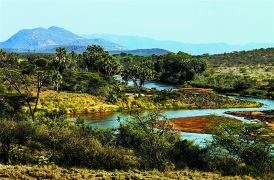
Across the Ewaso Nyiro river which is winding through a mature stands of Newtonia and Sycamore Fig trees, Acacia and Doum Palms, connected by a bridge, is the smaller
Buffalo Springs National Reserve and nearby is the swampy wilderness of the Shaba National Reserve, named after Mount Shaba (1525m). That makes it easy to combine Samburu on your individual Safari
with Buffalo Springs and/or Shaba.
Meru National Park
Meru National Park is situated in central Kenya in the Meru district of Eastern Province, around 350 km or 220 miles northeast of Nairobi and right on the equator. The pristine
landscape of it's 870 square kilometers is characterised by wooded grasslands in the west, thorny bushland in the north and open savannah elsewhere. It also offers the Tana and
other rivers and swamps with dense riverine forests of Doum and Raffia palm. Many rocky outcrops provide not only great lookout points for wildlife but (in south west direction)
also excellent views of the snow-capped Mount Kenya.
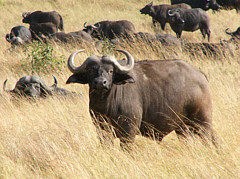
In Meru you will find Grevy's zebra, elephant, eland, bush pig, waterbuck, cheetah, leopard, reticulated giraffe, hippo, Bohor reedbuck, hartebeest, lesser kudu, duiker, Kirk's
dik-dik, large herds of buffalo, snakes like python, puff udder and cobra as well as more than 300 recorded species of birds. After re-introduction the park now
boasts over 67 rhino in its large Rhino sanctuary. Most of these animals are easy to spot from your
safari vehicle, but nevertheless you should carry binoculars and a sufficient tele lens for your camera. As this park is more remote and doesn't have such large numbers of visitors,
you don't have other vehicles of tourists sharing sights with you.
Meru National Park is located in a semi-arid zone at an altitude of between 1000 to 3400 feet (300 to 1000 meters) above sea level and has irregular rainfalls. Wet seasons are
April to June and November/December. Rainfall is higher in the western (around 650mm per year) than in the eastern parts of Meru (around 325 mm per year). The temperature is
generally lower than in the coastal plains and varies with the altitude. Best months for a visit are January and February as well as June to September (sunniest times) but as
rainfall is very low, also the other months are eligible to pay a visit to Meru.
Like Samburu, Meru also became famous through George and Joy Adamson and their work on lion and cheetah research.
Aberdare National Park
Aberdare National Park is situated in Kenya's central highlands, to the west of Mount Kenya and around 100 km (62 miles) north of Nairobi. The 766 square kilometers of the National
Park occupy the volcanic range that forms the eastern wall of the Great Rift Valley. The Aberdares range is dominated by two peaks separated by a saddle of high moorlands. The latter
is situated at 3,000 meters (9,840 feet) and the peaks of Kinangop in the south reach up to 3,906 meters (12,814 feet) and Ol Donyo Lesatima in the north up to 3,999 meters (13,123
feet). The topography of the National Park contains a wide variety of terrains with deep gorges that cut through the forested eastern and western slopes of the Aberdare Mountains,
topped with their rugged peaks. The red volcanic soil of Aberdare provides best conditions for rich vegetation. Despite beeing so near to the equator, the high altitude determins the
climate, resulting in cooler temperatures and more rainfall.

Beside the beautiful mountain landscape and the Chania and Karura waterfalls the Aberdares are a good spot to observe kenyan wildlife. The park is home to the second largest
population of the endangered black rhino wich may be spotted at one of the forest lodges' salt licks on the eastern slopes. Also the Sykes monkey and the black and white colobus
monkey can be found here as well as the bongo, that's an elusive forest antelope that lives in the bamboo forest. Further elephant, baboon, buffalo, bush pig, giant forest hog,
leopard, serval and - more rare - lions and the golden cat can be spotted.
Bird watching at the Aberdares is rewarding; there are over 250 different species recorded in the park, including the Jackson's francolin, sparry hawk, goshawks, eagles, sunbirds
and plovers.
Best times to visit Aberdare National Park are January/February and the months from June to September. The main rainy season from March to May should be avoided because the
roads become impassable and also the short rainy season from October to December may cause some access problems.
Lake Nakuru National Park
Lake Nakuru National Park is situated in central Kenya in Nakuru district of the Rift Valley Province, around 150 km northwest of Nairobi, a leisurely two hour drive on good
roads, leading through the majestic Great Rift Valley, winding through a series of lakes and forested uplands all the way to the bustling market town of Nakuru.
The National Park covers an area of 180 square
kilometers (69.5 square miles) and comprises of the large, shallow lake (about a third of the National Park), fringed by alkaline swamps and surrounded by mainly wooded and
bushy grasslands as well as dry savannah. Rocky hillsides on the Parks eastern perimeter are covered with scrub and a magnificent Euphobia candelabrum forest.
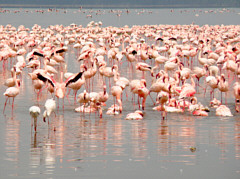
The lake is world famous as the location of the greatest bird spectacle on earth - huge numbers of pink flamingo, both greater and lessser flamingo, often more than a million
individuals that breed and nest at the edge of Lake Nakuru, giving it the characteristic pink rim. The lake water supports a dense bloom of the blue-green Cyanophyte Spirulina platensis from which it derives its colour and which is the major food source for the
flamingos that can be found wading on the water's edges. From one of the view points (Lion hill, Baboon cliff or Out of Africa) they look like an enourmus pink living shawl wrapped
around the edge of the lake. But also other birds can be found here in large numbers such as great white and pink-backed pelicans, cormorants, stilts, avocets, ducks, spoonbills,
storks, herons and kingfishers. Further african fish eagle, martial eagle and verraux eagle. The total number of bird species recorded in Lake Nakuru National Park is nearly 450.
The National Park also provides about 56 different species of mammals including black and white rhino, buffalo, large herds of waterbuck (both kenyan species), zebra,
different kind of gazella and antelope, warthog, hippo and the rare Rothschild giraffe, translocated for safety from western Kenya in 1977. Among the predators are lion, cheetah
and leopard.
Lake Nakuru National Park located at an altitude of 4,000-5,767 feet above sea level and the climate is pleasant with daytime temperatures between 23 and 26 degree C and there are only occasional rainfalls so the National Park can be
visited all year round.
Amboseli National Park
Amboseli National Park is situated in southern Kenya, in Loitoktok District of the Rift Valley Province, around 260 km or 160 miles from Nairobi on the border to Tanzania.
Amboseli provides an awesome view of Africa's highest mountain, Mount Kilimanjaro (at 5.,895 meters) which seems to be within easy grap. As far as it's not covered in clouds it will
make a magnificant background for your safari photos!
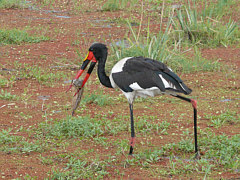
The 392 square kilometers (151 miles) of the National Park consist of a mixed topography of open plains, acacia woodlands, rocky thorn bushes, swamps and marshes. As it's in the
rain shadow on Mount Kilimanjaro's north western side, the climate in Amboseli is hot and very dry. The average temperatures vary only slightly during the year. Daytime temperature
is between 27 and 33 degree C (81 - 85 degree F) while nighttime temperature is around 22 to 24 degree C (72 to 75 degree F). During rainy seasons from April to May and
November/December the total annual rainfall is just 300 mm, so drought and high evaporation are typical for this area. Accordingly, Lake Amboseli is only filled with water after the
rains; at all other times it's a dry, flat lake basin. (Amboseli means 'salty dust' in maa, the language of the Maasai)
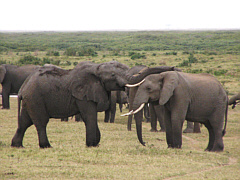
Despite the relatively dry conditions, a great variety of wildlife is to be found in the park, watered by the wide swamp areas. First of all the large herds of elephants Amboseli
is renowned for. In total today's number of elephants in Amboseli shall be more than 900 individuals. Due to the 30 year work of Cynthia Moss' famous 'Amboseli Elephant Research
Project' which identified and recorded more than 1,400 elephants, their family structure, life cycle and behavior, Amboseli's elephants are best known to the scientific world. The
park is famous for being the best place in Africa to get close to free-ranging elephants among other wildlife species. And it's really stunning to sit back in your safari vehicle and
observe a group of elephants interacting for some time!
Amboseli is also home to huge herds of wildebeest, to zebra, various gazella and antelope, predators like leopard, cheetah and lion, to buffalo, giraffe, mongoose, hyrax and
nocturnal porcupine. Due to the long dry months Amboseli's vegetation is sparse and offers good opportunities to spot and observe wildlife. Among the 600 bird species reported for
Amboseli are many water fowls like ducks and goose as well as eagles, various storks and herons feeding on fish and amphibians. Especially between October and January, the european
winter time, many migratory birds can be observed in Amboseli.
Best months for a visit to Amboseli are January, February and June to October. During the rainy seasons from April to May and, to a lesser degree, in November/December the
Amboseli roads with their loose surface of volcanic soil are more or less impassable.
Tsavo East National Park
Tsavo East National Park is located in south-east Kenya, around 330 km from of Nairobi. It's one of the oldest and largest National Parks, stretching over 11,747
square kilometers. Despite substantial areas in the north of Tsavo East are designated as 'remote animal wilderness' and therefore not accessable, the remaining area open to the
public is still very huge. Tsavo East provides a variety of different landscape from dry savannah plains over thornbush areas to swampy marshlands and rocky hills. Galana and
Tsavo River water the National Park and it's inhabitants.
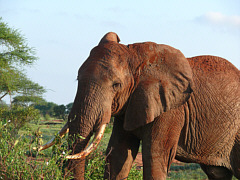
Tsavo East is famous for it's huge population of elephants, all red from the elephant's habit of first taking a bath in water and afterwards dusting themselves with the red Tsavo
soil. The park is also home to large herds of zebra, bufallo, giraffe and impala, Grant's gazelle, oryx gazelle, hartebeest, waterbucks and the giraffe-like gerenuk gazelle. Often
seen predators are lions, while cheetah and leopard are not as easy to spot. The rivers and the seasonal lake at Aruba Dam are home to crocodile and hippo. In Tsavo East you will
also see baboon, vervet monkey, warthog, mongoose and rock hyrax.
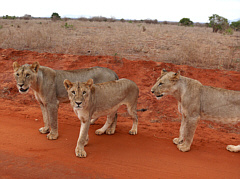
Over 500 bird species have been recorded in the park, including ostriches, bustards, secretary birds, eagles, herons, hornbills, kingfishers, starlings, weavers and many more.
During the period from October to January you will also see lots of migratory birds spending the european winter in Tsavo.
As the park is relatively close to the coast (only 170 km to Mombasa) the climate is tropical with daytime temperatures around 27 to 31 degree C (81 to 88 degree F) and 22 to 24
degree C (72 to 75 degree F) at night, fairly constant all year round. Best months to visit Tsavo East are January, February and June to September. The small rainy season from
October to December is also good as it only rains occasionally. During the bigger rainy season from March to May heavy rainfalls may occure and handicap driving on the red soil park
roads.
Tsavo West National Park
Tsavo West National Park is located in south-east Kenya, around 240 km from Nairobi, along the western side of the Nairobi-Mombasa highway and borders Tanzania to the south. Only
slightly smaller than it's sister Tsavo East, it stretches over 9,065 square kilometers. Tsavo West provides various different landscapes with hills and mountains, rocky ridges,
open grasslands, semi-arid desert-scrublands, Acacia woodlands and belts of riverine vegetation with palm trees. The mountains and hills are of vulcanic origin and several lava
flows like Shetani and Chaimu report of recent eruptions only some hundred years ago. The altitude of the park ranges from 200 to 1000 meters above sea level.
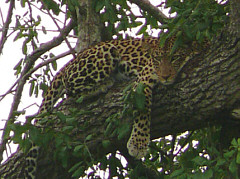
In Tsavo West you have a good chance to see leopard and black rhino (there is a fenced protection area for black rhino within the park), elephant, giraffe, lesser kudu, zebra,
waterbuck, lion, buffalo, baboon, vervet monkey, mongoose and rock hyrax. Around 600 bird species have been recorded in Tsavo West, including eagles, hawks, herons, ostriches,
kingfishers, weavers, hornbills, buzzards, secretary birds and many more. During the period from October to January you will also see lots of migratory birds spending the european
winter time in Tsavo.
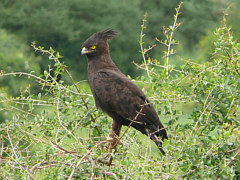
A special attraction is Mzima Springs, a natural well whose water covers a journey of 50 kilometers underground through volcanic rocks before getting to the surface. The spring
produces a clear stream that flows through a series of pools, surrounded by rich vegetation of Acacia trees, date and raffia palms, figs and others. The trees are home to vervet
monkeys and various birds while the water is the habitat of crocodiles, hippos and several kind of fish, easy to watch from the windows of a submerged viewing point in one of the
pools.
As the park is relatively close to the coast (only 190 km to Mombasa) the climate is tropical with daytime temperatures around 27 to 31 degree C (81 to 88 degree F) and 22 to 24
degree C (72 to 75 degree F) at night, fairly constant all year round. Best months to visit Tsavo West are January, February and June to September. The small rainy season from
October to December is also good as it only rains occasionally. During the bigger rainy season from March to May heavy rainfalls may occure and handicap driving on the red soil
park roads.
|